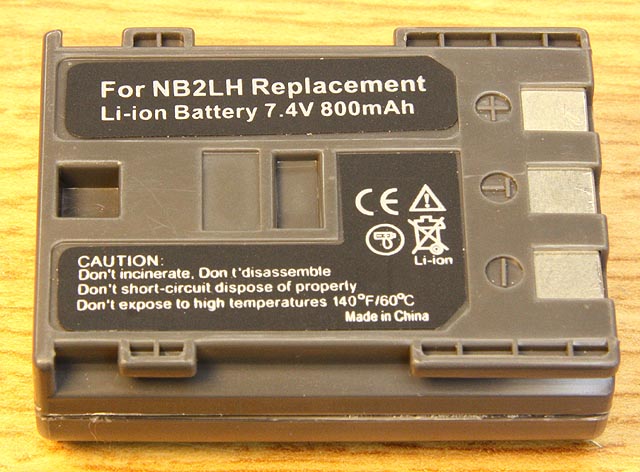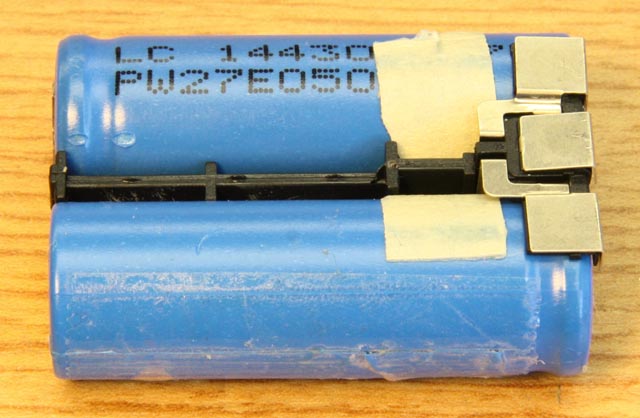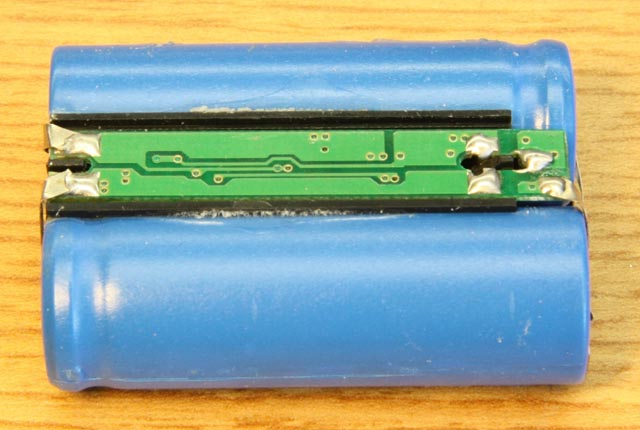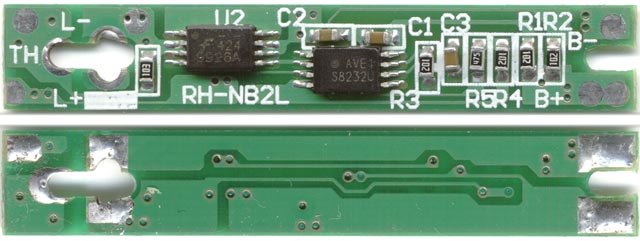|
|
|
|
|
|
This is a Chinese clone of the rather popular Canon battery pack NB2LH used in several of Canon's devices. As far as I can remember, I bought it for 3.50 € approx. from some eBay seller.
I was curious about the inside of such a battery pack, particularly a clone. Now that this one had failed (because I hadn't charged it for a few years - so it was not necessarily due to poor quality of the clone), I dared to open and "destroy" it. On the enclosure it says: "Don't disassemble" and I totally agree: It is not easy to open, the cells can be damaged, and during further disassembly a short circuit is quite likely. A short circuit can easily lead to an overheating and burning lithium cell and you may know how dangerous that is!

When you look closely you may recognize that this photo was taken after the case had been opened.

I injured the cell's isolation when I opened the case. Because I expected and feared that, I was careful enough not to injure the cell itself.

The cells are glued to the center plastic spacer. My first little surprise was the fact, that obviously some electronics were inside the battery pack.

Only one of the cell's terminals is directly connected to the outside tab.

The electronic board contains a standard 2-cell lithium battery protection circuit. U1 (the right one) is a 2-cell lithium battery protection controller S8232U, e.g. from Seiko Instruments, U2 (the left one) is a dual N-channel MOS-FET FDW9926A from Fairchild Semiconductor. The circuit prevents the battery from overcharge, overdischarge and overcurrent. It does not "balance" the cells, i.e., instead of charging the remaining cell only when the other one has reached its charge voltage limit, with this controller the charge process is completely stopped.
This is the basic circuit diagram of this (and probably almost each other) small Li-Ion battery pack. Note: It is obvious that what on the battery pack often appears to be a "Ground" sign actually is a "T" for "Temperature".
For details have a look at the datasheet S8232U, particularly the controller's block diagram on page 2 and the application example on page 18. The circuit here will be the same with the exception that the battery pack's center tab (the middle one of the three) is connected by a 10 kΩ resistor to the battery pack's Minus-tab (the leftmost resistor on the photo above). In the circuit diagram I pictured a 10 kΩ NTC resistor which should be used at this position instead of the 10 kΩ fixed resistor .
The missing NTC: A safety risk?
Though a simple connection to ground actually would do, up to now I thought that this 10 kΩ resistor is meant to be an indicator for the battery charger that a battery pack is inserted. But I was skeptical enough to test another battery pack (Canon LP-E5) together with a clone (Ansmann A-Can LP E5, "Made in China"). I found out that in the original battery pack an NTC (10 kΩ at room temperature, 5 kΩ when quite warm and 15 kΩ out of the fridge) is used where in Ansmann's clone still the fixed 10 kΩ can be found. I could imagine two reasons for this NTC: 1. the NTC is provided for a temperature controlled charging voltage and/or 2. it serves to interrupt charging at too high and/or too low temperatures.
In the literature I did not find anything about the need of a temperature controlled charging voltage and by an experiment I could not find any hint that the charger behaves like this either. But the charger indeed interrupted charging the battery when the resistor was lower than 4.5 kΩ or higher than 30 kΩ approx., which for an NTC with avarage characteristics would correspond very roughly to 0°C and 40°C (32°F and 104°F).
Obviously this NTC is not meant to be a safety measure in the sense of preventing the battery pack to burn, or so. It is just meant as a protection measure to prevent the cells of being charged outside the permissible temperature range. Actually I wonder how or, to be more precise, under which circumstances the NTC's temperature information could prevent anything from any seroius danger: When the cells are hot something must have gone so seriously wrong that just switching off the charge current would not help at all.
Conclusion
After having experienced this replacement of an NTC by a simple resistor in two different battery pack clones I am quite sure that this will be usual in most (or even all?) other clones, too. On one hand I personally don't mind when my cheap battery pack is not protected against being charged outside the permissible temperature range - it is so much cheaper that I can easily get over it, particularly because I'm an "indoor user" only. My original credit to the clones is "reduced", not lost. On the other hand I find it to be a shame that the manufacturers omit this NTC for the benefit of fractions of a cent. Or didn't they realize what kind of component that little thing was when they copied the product?
| Last update: October 13th, 2015 | Questions? Suggestions? Email Me! | Uwe Beis |